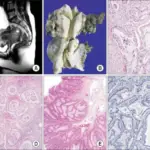Fibromas are benign tumors that are composed of fibrous or connective tissue. They can grow in any organ.
What is the Pathology of Fibromas?
The pathology of fibromas is:
-Etiology: The cause of fibromas is unknown.
-Genes involved: TP53, ESR1 gene/
-Pathogenesis: The sequence of events that lead to fibromas are: due to hereditary or sporadic genetic abnormalities, the ovarian stromal cells are transformed into neoplasms.
-Morphology: The morphology associated with fibromas shows Well circumscribed mass with smooth, lobulated surface.
-Histology: The histology associated with fibromas shows nonencapsulated, Variably cellular fascicular or less frequently, storiform growth of tumor cells.
How does Fibromas Present?
Patients with fibromas typically are females Mean age 48 years, uncommon before 30. The symptoms, features, and clinical findings associated with fibromas include: ovarian mass, such as abdominal pain, pelvic pain, abnormal bleeding, prolonged periods or distension and increased urinary frequency.
How is Fibromas Diagnosed?
Fibromas is diagnosed by blood tests for CA125 levels, pelvic examination, ultrasonography, CT scan, MRI.
How is Fibromas Treated?
Fibromas is treated by surgical excision salpingo-oophorectomy, oophorectomy or ovarian sparing procedure, hysterectomy, myomectomy.
What is the Prognosis of Fibromas?
The prognosis of fibromas is excellent. Cellular fibromas may recur, often after a long interval, warranting long term follow up.



